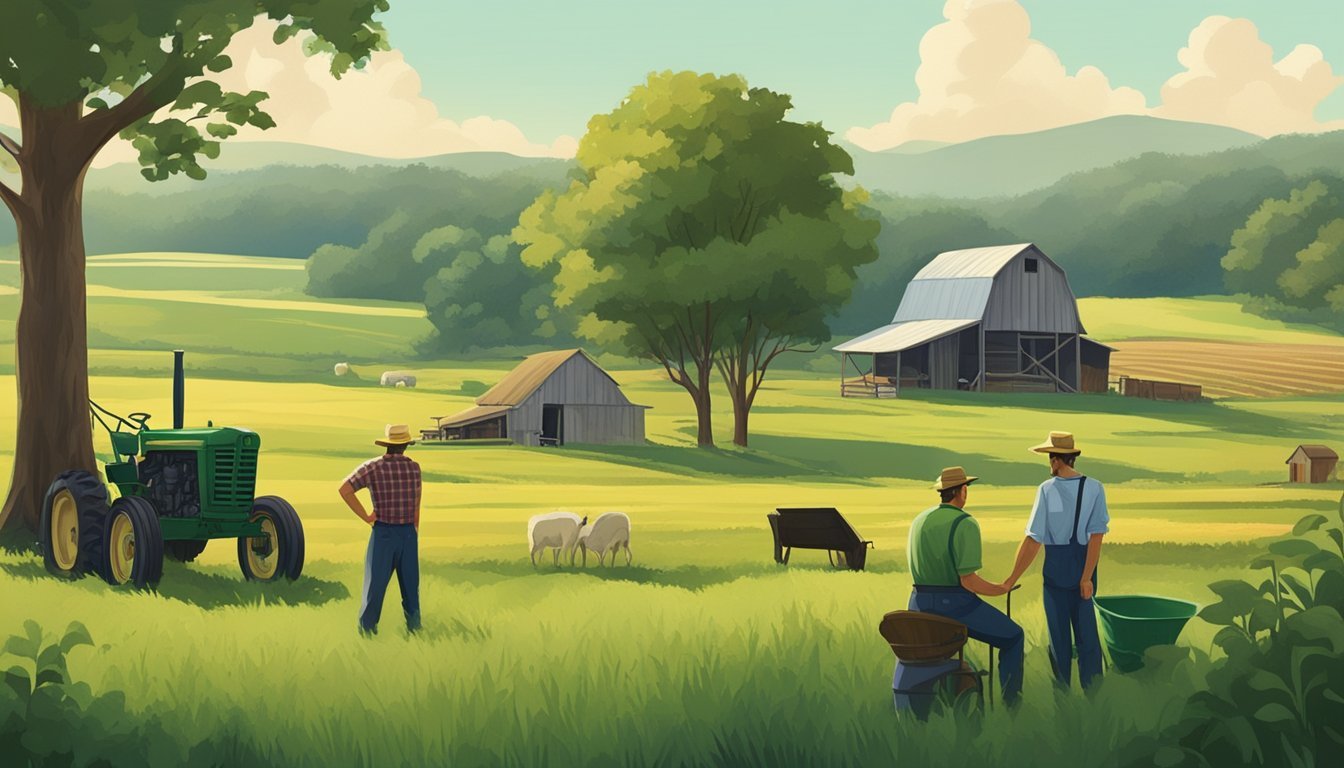Farm Loans in Alabama
Navigating Your Agricultural Financing Options
This Article is Part of Our Guide on Farm Loans for All 50 U.S. States
Farm loans are a critical aspect of supporting Alabama's agricultural sector, providing essential financial assistance to farmers and rural landowners. Agriculture is a significant part of Alabama's economy, and access to credit is vital for maintaining and growing farming operations. These loans facilitate a range of activities from purchasing land to making improvements, covering operating costs, and even investing in conservation efforts.
Alabama farmers and landowners have access to various lending programs catered to the specific needs of rural and agricultural financing. Local cooperative organizations, such as Alabama Farm Credit and Alabama Ag Credit, play a pivotal role in the landscape of farm lending. They offer customized loan programs, including financing for land purchases, construction, ag-related improvements, and other operating expenses.
Moreover, these cooperatives serve not just the financing needs but also provide additional services like leasing, insurance products, and cash management. The cooperative structure of these lending institutions means they operate with a borrower-centric approach, often allowing for more flexibility in terms and rates. Their deep understanding of local agricultural needs ensures that financial solutions are closely aligned with the goals of Alabama's farming community.
Understanding Farm Loans in Alabama
Farm loans in Alabama are essential for both new and experienced farmers, intended to support various aspects of their agricultural activities. These loans come in different types, each with specific eligibility requirements, and the application process is streamlined for efficiency.
Types of Farm Loans
Alabama farmers have access to a range of loan types to fit their unique needs. These include:
Operating loans: To cover day-to-day expenses such as seed, fertilizer, and livestock.
Equipment loans: For purchasing tractors, combines, and other farm machinery.
Land loans: Aimed at assisting with the purchase of rural land for farming expansions.
Improvement loans: For ag-related infrastructure improvements.
Each loan type is designed to aid farmers in growing and maintaining their operations successfully.
Eligibility Requirements
Eligibility for farm loans in Alabama typically revolves around the following criteria:
Creditworthiness: A borrower's credit score is a vital determinant, as it reflects their ability to repay the loan.
Farm experience: Lenders may evaluate the borrower's experience and history in farming.
Type of farming activity: The intended use of funds should align with eligible farming or agricultural activities.
Prospective borrowers should verify with their lender for detailed eligibility requirements.
Application Process Overview
The loan application process in Alabama involves several steps:
Initial Contact: Borrowers should reach out to a loan officer or apply directly through the lender's website.
Documentation: They must gather necessary documents, including proof of income, credit reports, and a business plan.
Evaluation: The lender reviews the application to determine loan suitability.
Approval: If the application meets all criteria, the lender will approve the loan and set terms and conditions.
Applicants are encouraged to consult with loan officers to ensure they understand the requirements and steps in the process.
Agricultural Lending Institutions in Alabama
In Alabama, agricultural lending institutions are vital for supporting the state's farming industry. They provide various financing options tailored for purchasing farmland, making improvements, and covering operational costs. Among these institutions, cooperatives like Alabama Ag Credit stand out for their specialized services and benefits to their members.
Alabama Ag Credit
Alabama Ag Credit is a key player in the state’s agrarian financial sector, offering an array of loan products for rural land purchases, refinancing, and improvements. This institution distinguishes itself by focusing specifically on rural land, including farmland, timberland, and recreational homesites. Its expertise in agricultural finance is forged through a long history of serving the specific needs of the rural community.
Commercial Banks vs. Cooperatives
Commercial Banks and Cooperatives are the primary structures for agricultural lenders in Alabama, each with its unique approach to lending.
Commercial Banks:
Primarily profit-driven.
Offer a broad range of financial services.
Clients do not necessarily have a say in governance.
Cooperatives:
Owned and governed by members who use their services.
Profits are often shared with members as patronage dividends.
Specialize in agricultural financing and have deep roots in the farming community.
Cooperatives often offer competitive land loan financing rates and have a deep understanding of the specific needs of farmers and landowners in Alabama. They operate with the goal of supporting their members' interests and ensuring that the agricultural community has access to necessary financial resources.
Loan Programs for Farmers and Ranchers
Farmers and ranchers in Alabama have several loan programs available to them that cater to a variety of needs from purchasing land to operating costs. From federal and state offerings to non-traditional lending options, these programs are designed to support the agricultural community in sustaining and growing their business.
Federal and State Programs
USDA Farm Service Agency (FSA) provides numerous loan options for farmers and ranchers. They offer assistance for purchasing land, funding for operating costs, and resources for expanding or maintaining farms. For example:
Farm Operating Loans: These can offer up to $400,000 to eligible borrowers and may cover forest operation needs as well.
Microloans: A subsection of operating or farm ownership loans targeted towards smaller-scale farming operations.
In Alabama, the USDA also works closely with state authorities to administer various programs:
Alabama Farm Credit: A cooperative delivering tailored loan programs, leasing, and insurance products to support farm purchases and ag-related improvements.
Non-Traditional Lending Options
Aside from federal and state programs, there are also non-traditional sources of funding for farmers and ranchers in Alabama. These entities might include local credit unions, agricultural lenders like Alabama Farm Credit, and other cooperatives that offer more flexible loan arrangements and might be particularly beneficial for smaller or beginning operations that might not initially qualify for traditional loans. These options often cater to the specific needs of rural communities and may offer competitive terms.
Customized Loan Programs: Aimed at providing more personalized financial products to suit unique agricultural needs.
Leasing Options: For farmers and ranchers considering leasing equipment or land.
Farmers and ranchers in Alabama have a varied landscape of loan programs to navigate, each with its own benefits suited for different types of agricultural operations.
Different Types of Credit Available
Alabama offers a diverse range of credit options to support various aspects of farming operations. These specialized loans cater to land acquisition, equipment and livestock purchases, and day-to-day farm management.
Land and Land Improvement Loans
Land loan specialists in Alabama understand the unique financial requirements for purchasing rural land. Land loans are designed to finance the acquisition of property, whereas land improvement loans are intended for developing or enhancing land for agricultural use. Alabama Farm Credit and Alabama Ag Credit are institutions that offer competitive rates and terms tailored for land purchases and improvements.
Equipment and Livestock Financing
When it comes to sustaining and expanding a farming operation, equipment and livestock financing is crucial. This type of credit allows farmers to purchase new machinery, replace aging equipment, or expand their livestock herds. Customized loan packages ensure that farmers can acquire the necessary assets to maintain their competitiveness and increase productivity.
Farm Operating Lines of Credit
A farm operating line of credit provides farmers with the flexibility to cover a variety of operational expenses. These can include crop production costs, routine maintenance, or unexpected expenditures. Having access to a line of credit ensures that farmers have the financial agility to manage cash flow throughout the agricultural season and make strategic decisions when opportunities arise.
The Role of Land and Agriculture in Alabama
Alabama's agriculture and land ownership are integral to the state's economy, driving its profitability through diverse crops and livestock.
Economic Impact of Agriculture
The agricultural sector in Alabama is a significant contributor to the state's economy, representing a multi-billion-dollar industry. Land in Alabama is primarily used for farming purposes, with rural property serving as the foundation for the state's agricultural output. The state's farmers gain profits not only through the direct sales of agricultural products but also through related agribusiness activities.
Popular Crops and Livestock
Alabama's temperate climate and fertile soil foster the growth of several key agricultural products. Here is a brief overview of the state's predominant crops and livestock:
Crops:
Peanut: Alabama ranks among the top producers in the nation, with peanuts crucial for both domestic consumption and export.
Cotton: Historically significant, cotton remains a cornerstone of Alabama's agricultural output.
Sweet Potatoes: The state's warm climate is ideal for growing sweet potatoes, which are a significant crop across Alabama.
Livestock:
Farming in Alabama is also characterized by its livestock production, which includes cattle and poultry. These livestock sectors are essential for both the state's meat supply and for export purposes.
Purchasing and Owning Farmland
When it comes to acquiring farmland in Alabama, individuals have the option to either purchase or lease, with each choice presenting its unique set of implications for conservation and land stewardship.
Buying Vs. Leasing Land
Buying land is a significant investment that conveys long-term control over the property. Purchasers can apply for loans through institutions such as Alabama Farm Credit to finance qualifying rural land for various purposes including agriculture, hunting, and residential retreats. Prospective buyers must complete a loan application and can consult with a loan officer to navigate the process.
In contrast, leasing land offers a less capital-intensive option with more flexibility but less permanence. Leasing allows farmers to gain access to agricultural land without the upfront cost of purchase, making it a feasible choice for new or expanding operations.
Conservation and Land Stewardship
Conservation is a vital consideration for farm owners in Alabama. By adopting land stewardship practices, owners contribute to the sustainability of their farms, the welfare of wildlife, and the preservation of natural resources. This may include implementing techniques to protect soil integrity, maintaining wildlife habitats, and managing water conservation.
When owners buy land, they have the autonomy to enact conservation practices that align with their long-term vision for the property. Conversely, leasing can limit the scope of permanent conservation initiatives due to the temporary nature of the arrangement. Landowners and tenants must often negotiate the terms on which conservation practices are implemented.
Additional Aspects of Farm Financing
When considering farm loans in Alabama, farmers and agribusinesses must evaluate additional financial facets beyond basic land acquisition. These facets include provisions for mitigating risks through insurance, as well as funding for new construction and farm buildings.
Insurance and Risk Management
A crucial element of farm financing is the incorporation of insurance to manage various risks associated with agriculture. Farmers can utilize insurance products to protect their assets, including crops, livestock, and equipment, from unpredictable factors such as extreme weather conditions, pests, or market fluctuations. Risk management strategies may also encompass farm liability coverage, ensuring financial protection against potential legal issues.
Building and Construction Loans
Funding for new construction is a significant consideration for agribusinesses looking to expand or enhance their operations. Construction loans are designed to finance the creation or renovation of farm buildings, such as barns, storage structures, and processing facilities. Such loans often feature customizable payment plans to align with the unique timelines and cash flows of construction projects. Agribusinesses can leverage these loans to ensure their infrastructure meets the evolving demands of the agricultural sector.
Loan Terms and Repayment Options
In Alabama, farm loans offer a variety of terms and repayment options to accommodate the diverse needs of farmers and ranchers. Understanding these can help borrowers manage their finances more effectively and select the best structure for their agricultural operation.
Understanding Flexible Loan Terms
Flexible loan terms are foundational to meeting the specific requirements of agricultural businesses. These terms often range from short-term financing options to long loans that span several years. They can be custom-fit to match the production cycles of farming and ranching operations.
Loan Duration: This can vary significantly, with some loans offering a fixed rate for the entire period, and others providing variable or adjustable rates.
Rate Options:
Fixed Rates: Interest rates remain constant over the loan's life, offering stability.
Variable Rates: Interest can fluctuate based on market conditions, providing potential savings.
Adjustable Rates: Initially fixed, these can change at predetermined points in the loan term.
Strategies for Loan Repayment
When it comes to repaying loans, borrowers and their loan officers can strategize to find the most manageable and cost-effective plan.
Regular Payment Schedules: Borrowers can opt for monthly, quarterly, or annual payments.
Flexible Terms:
Interest-Only Payments: Some loans allow payments on just the interest for a period before repaying the principal.
Balloon Payments: In certain cases, smaller regular payments culminate in a larger final payment.
Refinancing Options: As financial situations change, borrowers may consider refinancing to take advantage of better terms or rates. Refinancing can adjust the loan structure to better fit current economic realities.
By discussing options with a loan officer, farmers can tailor their repayment plan to suit their unique situations, potentially easing financial pressure during leaner production periods.
Supporting Rural Lifestyle and Diversification Functions
In Alabama, farm loans support the development of rural communities through financing for homes with a rural lifestyle and for projects that diversify agricultural income. These loans are essential in managing and improving land for various purposes including residences, agriculture, hunting, and fishing.
Loans for Homes and Rural Lifestyle
For individuals seeking to purchase or improve rural property in Alabama, USDA Farm Service Agency and Alabama Farm Credit offer loan programs that cater to their needs. Farm Ownership Loans can be utilized to acquire new land, expand existing properties, construct and upgrade rural homes, and address soil and water conservation concerns. These loans also facilitate rural financing that includes coverage for closing costs and land improvement for recreational activities like hunting and fishing, enhancing the quality of rural life.
Agricultural Diversification and Non-farm Income
Alabama's rural financing services understand the importance of diversification for farm sustainability. Loans tailored for agricultural diversification are available, providing financial support for activities that extend beyond traditional crop production. This may cover ventures in agri-tourism, value-added products, or renewable energy projects. Farm Operating Loans assist with operating costs and can impact non-farm income streams, such as rural B&Bs or outfitter services, which enrich the rural economy. Rural property owners are thus empowered to invest in diversified projects, contributing to financial stability and community development.








